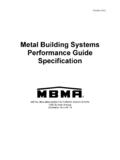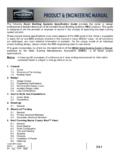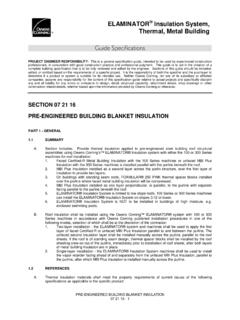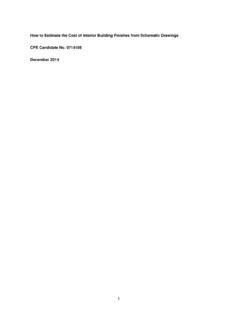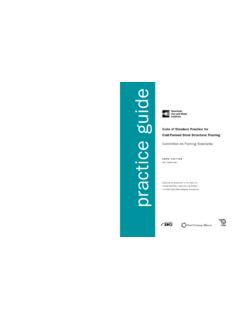Transcription of METAL BUILDING INFORMATION GUIDE - Indaco Metals
1 Indaco Metals , LLC. RIGID BUILDING SYSTEMS 3 AMERICAN WAY, SHAWNEE, OKLA. 74804 PH: 405-273-9200 FAX: 405-275-9206 1 METAL BUILDING INFORMATION GUIDE This bulletin is designed to aid the METAL BUILDING buyer in the purchase of a rigid BUILDING system. What is a rigid BUILDING ? A rigid BUILDING is a BUILDING that most or all of the support structure is made up of I beams. Light duty truss type buildings are made using square and/or rectangular steel tubing as a support structure. Virtually every rigid type BUILDING design is different. The almost limit less BUILDING design options makes it difficult for the buyer to obtain quotes from different suppliers that are not significantly different in costs. The purpose of this sales bulletin is to identify some of the design variables that can significantly affect costs. BUILDING CODES & EDITIONS: BUILDING codes are design code requirements established by a governing body that all buildings must adhere to.
2 All major cities establish a certain governing body BUILDING code that all buildings constructed within their boundaries must meet. In addition some cities may have special local requirements as well. BUILDING codes commonly used through out the United States are: IBC- International BUILDING Code IBC 03 Edition BOCA- BUILDING Officials and Code Administrations BOCA 99 Edition UBC- Uniform BUILDING Code UBC 97 Edition METAL BUILDING manufacturers association (MBMA) is not considered a BUILDING code because its content is limited to structural design criteria. If no specific BUILDING code is required for the customer s location, Indaco Metals designs all its buildings to meet the requirements of International BUILDING Code IBC 03 Edition, unless otherwise specified by the customer. It is important that the customer specify the correct BUILDING code for their location as BUILDING costs can vary significantly depending upon which design code and edition is used.
3 END USE CLASSIFICATIONS: BUILDING codes require a safety factor classification of a BUILDING determined by BUILDING usage. For instance, a commercial type BUILDING where people are present most of the time will have a higher safety factor classification than a general storage BUILDING . The higher the safety factor rating, the higher the cost of the BUILDING . Indaco Metals designs all its buildings for agricultural end use unless otherwise specified by the customer. WIND SPEED & EXPOSURE: Wind speed that the BUILDING is designed to withstand. Wind exposure is a rating in the BUILDING code that accounts for wind pressure on a BUILDING due to geographical location. Exposure ratings are expressed as the letters B, C, & D. B is the lowest exposure rating and D the highest. Buildings designed to the higher ratings are considerably higher in cost. When comparing quotes from different suppliers be sure wind exposure ratings are correct for your site and all the same.
4 Indaco Metals , LLC. RIGID BUILDING SYSTEMS 3 AMERICAN WAY, SHAWNEE, OKLA. 74804 PH: 405-273-9200 FAX: 405-275-9206 2 DEAD LOAD: The dead load of a BUILDING is the total weight of all the materials used to construct the BUILDING . This would include the walls, roofs, structural items, and other optional items such as stairways, cranes, and the floors of multi-story buildings. COLLATERAL LOADS: A collateral load is the additional weight (above the dead load) on the BUILDING supports for such things as insulation, water sprinklers, suspended ceilings, and ductwork. These loads must be included when designing the BUILDING . The higher the collateral load required the more expensive the BUILDING . When comparing BUILDING quotes from different suppliers, be sure additional costs for collateral loading is included. AUXILIARY LOADS: Auxiliary loads are loads induced by such items as air conditioning units or large exhaust fans placed on the roof. This also includes cranes and material handling equipment supported by the buildings frame structure.
5 These loads must be included when designing the BUILDING . The addition of these types of items can significantly increase the cost of a BUILDING . ROOF LIVE LOADS: Roof live loads are temporary loads produced during maintenance by workers and/or temporary placement of equipment or materials on the roof. The applicable BUILDING code will specify the live load value in , based on roof slope and end use. DEFLECTION: Deflection of a BUILDING component can be defined as the movement of a structural member relative to its supports due to an applied load(s). A BUILDING with METAL panels will have much more deflection or movement than a masonry wall. This movement may be an important consideration depending on the design of the BUILDING . Additional bracing or other design changes to the support structure may be required if large quantities of less flexible materials are incorporated in the BUILDING design. This can have a significant effect on the cost of the BUILDING .
6 When comparing quotes from different suppliers the customer should make sure that any design changes made because of deflection are included. BUILDING COMPONET PARTS Indaco Metals , LLC. RIGID BUILDING SYSTEMS 3 AMERICAN WAY, SHAWNEE, OKLA. 74804 PH: 405-273-9200 FAX: 405-275-9206 Gutters and down spouts are not quoted on a BUILDING package by Indaco Metals unless the customer requests it. This option is a significant cost addition to a BUILDING package. If gutters and down spouts are required make sure they are included on all quotes from each supplier. 3 ROOF AND WALL PANELS Panel thickness: 26 gauges and 29 gauges are common size gauges used for METAL buildings. The lower the number the thicker the steel panel. The thicker panels are stronger and will withstand higher wind loads. It is also more expensive. Indaco Metals uses 26 gauge METAL for all panels unless otherwise specified by the customer. When comparing quotes make sure the same gauge panel is being quoted by all suppliers.
7 Panel finishes: Acralume and Galvalume (Metallic finishes) are significantly less expensive than siliconized polyester color painted panels. Color panels can be purchased with either a 10 year or 25 year warranty on the painted coating. INSULATION If insulation is required make sure the type of insulation being quoted is the same on all quotes. Insulation is a significant cost of a BUILDING package. Indaco Metals only supplies fiberglass blanket type insulation in two standard sizes and also custom cut to fit a particular size BUILDING when required. All insulation supplied by Indaco Metals is a fibrous glass blanket certified R value by the National association of Home Builders Research Laboratories (NAHBR). Some suppliers do not supply R certified insulation. ENTRANCE DOORS Walk through entrance doors are available in different widths and types of hardware. Lever action door openers (ADA compliant) are more expensive than the standard ball type opener.
8 Indaco Metals supplies a 36 wide by 84 high door with the standard ball type opener on all BUILDING packages unless otherwise specified by the customer. Other types of door hardware are also available if required. Indaco Metals does not supply overhead doors. GUTTERS AND DOWN SPOUTS GIRTS A girt is a purlin that has been mounted to the side and end walls of a BUILDING frame to which the wall panels are attached. It also provides added strength to the BUILDING frame to resist wind loads. Girts are mounted in one of two ways, either flush, which is even with the support beams, or bypass when it is mounted on the outside of the support beam. No matter which style is used it does not add a significant cost to the BUILDING package. Indaco Metals designs all its buildings with flush mounted girts unless otherwise specified by the customer. Indaco Metals , LLC. RIGID BUILDING SYSTEMS 3 AMERICAN WAY, SHAWNEE, OKLA. 74804 PH: 405-273-9200 FAX: 405-275-9206 4 ANCHOR RODS Indaco Metals does not include anchor rods on its quotes.
9 FREIGHT The Freight cost to the job site is included in Indaco Metals quotes. Some suppliers do not include freight costs in their quotes. ROOF PANELS The PBR panel is the standard panel profile used on all Indaco Metals rigid buildings systems. The PBR panel is a superior quality panel compared to the standard R panel because of the increased overlap area between each panel. The increased over lap area creates a lap joint that is more resistant to leakage and also increases rigidity of the joint making installation easier. A PBR panel is more expensive than the standard R panel. When comparing quotes make sure all suppliers are quoting PBR panels. Indaco Metals will also provide standing seam roof panels if specified by the customer. Standing Seam roof panels will add a very significant cost to the BUILDING package and also to the construction costs.
10 SUPPORT COLUMNS & RAFTERS Support columns and rafters can either be tapered or constant depth. Indaco Metals designs its buildings utilizing both types depending on width and height of BUILDING . Constant depth support columns and rafters are used with smaller size buildings (12 high or less-40 wide or less). Larger buildings are designed using tapered depth support columns and rafters because they can be designed with adequate strength to support the BUILDING but at significantly less cost. Indaco Metals will design a BUILDING with whatever type support columns and rafters a customer specifies. END WALL FRAMES The three types are light or bearing, half load rigid, and rigid. (A) Light or Bearing- This type of end wall framing utilizes closed C purlins as the support columns and rafter. It is the most economical of the three, but has sufficient strength to support the BUILDING . It cannot be utilized under the following conditions (1) it cannot support an overhead crane.

